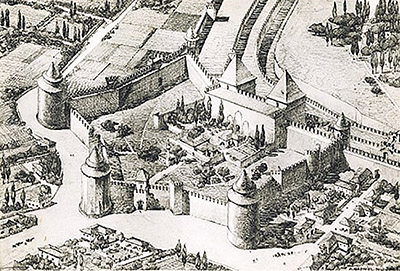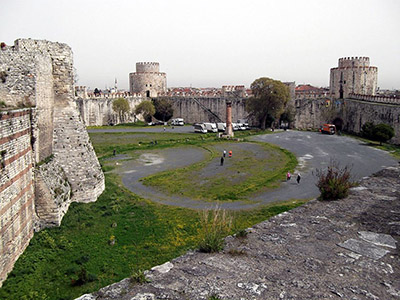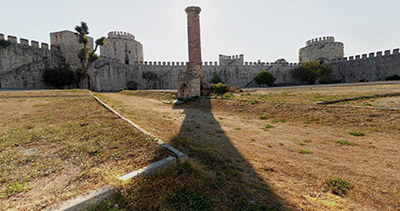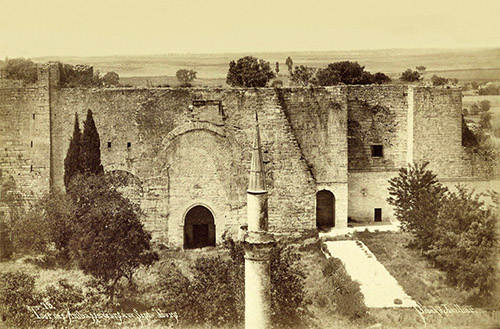 |
Yedikule Fortress
Istanbul, Turkey
|
|
 |
Constructed: 1458
Used by: Turkey
Conflict in which it participated:
None
Also known as: Seven Towers Dungeons
|
While obviously a fort shaped like a star, Yedikule Fortress is not really a starfort. Built in an age before artillery had made its presence known as the reliably wall-crumbling juggernaut that it would soon become, Yedikule Fortress' designers stumbled upon the benefits of the shape that would be the wave of the future of fortification.
|
 |
|
|
Anyone who paid any attention in their middle school history classes knows that Constantinople (today known as Istanbul) has played an important role in the eastern hemisphere practically ever since there was an eastern hemisphere. The area was first settled around 7000BC, and the city of Byzantium was founded there by Greeks around 660BC.
As generally seems to be the case in history, land in the vicinity of impressive waterways tends to get settled early and often...and there aren't many waterways more impressive than the Bosphorus Strait, which connects the Black Sea with the Sea of Marmara, and eventually the Mediterranean. Byzantium was the place where Europe met Asia, and to whence the Roman Empire retreated when those pesky Goths ejected it from Rome in the 5th century. The resulting Byzantine Empire lasted for another thousand years. The city of our current interest took its new name, Constantinople, from Roman Emperor Constantine the Great (272AD-337), who had been responsible for beginning the shift of the Roman Empire to its new home in the east.
|
 Yedikule Fortress in 1653. Yedikule Fortress in 1653.
|
 |
Through most of the Middle Ages, Constantinople was the richest, and at times largest, city in Europe. Wicked Islamic hordes dashed themselves to pieces on the city's walls for centuries, but all of the violence in the region caught up with Constantinople in 1204.
The Fourth Crusade (1202-1204) began as a Western European attempt to capture Jerusalem from the Muslims, but somehow degenerated into those intrepid Western European knights laying waste to Constantinople, which was neither Jerusalem nor controlled by Muslims. Constantinople was rebuilt, but was now in a downward spiral.
|
|
|
The Ottoman Turks changed tactics in the mid-14th century, gradually capturing smaller towns around Constantinople and thus cutting off the city's supply routes. Constantinople finally fell to the Turks, led by Mehmed the Conqueror (1432-1481), on May 29, 1453, after an eight-week siege. Mehmed proclaimed Constantinople to be the new capital of the Ottoman Empire.
|
Mehmed lavished his new shiny jewel of a city with much love, affection and construction. The location where Mehmed had Yedikule Fortress built had previously been the Golden Gate (so named because it was adorned with gold), the main entrance to Constantinople in which palatial apartments existed for visiting foreign rulers and ambassadors. Adding three towers to the pre-existing four towers created Yedikule Fortress, which occurred in 1458. This edifice was initially intended to serve much the same purpose for the Turks as it did for the ex-Romans. And it is with the initial construction of Yedikule Fortress that we must deal with the weird truth that this star-shaped fortress predates the introduction of the first starforts in northern Italy by about 30 years or so. The Fortezza di Sarzana just north of Pisa, Italy may not be the very first starfort, but it's the earliest example of the craft that I've come across thus far, with its construction beginning in 1487. Aside from the basic outer shape of a star, Yedikule Fortress doesn't have much else in common with the European starfort as we've come to understand it. Yedikule's walls are relatively thin, and there seems to have been no attempt to make it possible to mount any sort of gun atop, or within, its bastions. This makes perfect sense, in that Yedikule Fortress wasn't ever intended to really be a fortress, if the function of a fortress is to defend itself and its surrounding area from an attacking force.
|
 |
The interior structure of one of Yedikule's corner towers. |
|
But where did its star shape come from? Was it just the ornamental fancy of Mehmed the Conqueror's engineers, or did someone have a brainstorm and realize the defensive advantage of mutually supporting bastions? As this fort was intended as a glorified gatehouse and stronghold of the Sultan's riches, my theory is that the star shape was just an aesthetic choice in this case. In fact, the connecting of three new towers to the four existing towers that made up the Golden Gate along Constantinople's city walls almost inadvertently guarantees a star shape.
However. Was it possible that some of the architects of the first Italian starforts had spent time in Constantinople and seen Yedikule Fortress? This seems unlikely, as Constantinople was ruled by the Ottoman Turks, who would have surely taken a dim view of visiting Christians, and who in fact tended to enslave every Christian upon whom they could lay their hands. My thought is that Yedikule Fortress and the first Italian starforts had absolutely nothing to do with each other.
|
 The inside of Yedikule Fortress: Roomy! The inside of Yedikule Fortress: Roomy!
|
 |
Whatever, Yedikule Fortress was immediately tasked with storing the Sultan's riches, serving as a treasury from 1458 until 1789. As would be the case with many a fort, Yedikule also operated as a state prison until 1800. Many ghastly torture implements reportedly exist there to this day, and the severed heads of executed prisoners were at one time lined up for the entertainment of all.
For a period in the 1850's the fortress was occupied by the Abdulmejid Zoo, and in 1871 it served as a "Women's Art House," in which up to 400 women worked. Creating art? Being art? Unexplained. After rotting for many decades, Yedikule Fortress was repurposed as an open-air museum in 1968.
|
|
|
Yedikule Fortress' seven towers were named thus:
- Young Osman Tower Named for Prince Genç Osman (1604-1622), who may or may not have been killed in this tower.
- Arsenal Tower Used as a munitions depot.
- Ahmet III Tower Destroyed in an earthquake, this tower was rebuilt by Sultan Ahmet III (1673-1736).
- Treasure Tower A veritable pirate's booty was stored in this tower.
- Tower Dungeon One of two towers used for the incarceration of those in need of incarceration.
- Top Tower The other of two towers used for the incarceration of those in need of incarceration.
- Flag Tower Assumedly a flag flew from this tower (duh), in which Janissaries, or the Sultan's elite bodyguard troops, were stationed.
|
Yedikule Fortress spent a few more decades abandoned and falling apart until it was finally leased to a private company in 2004. Concerts, plays and festivals were held within the fort's grounds for several years, but local eyewitnesses report that it is again closed to the public, for the most part abandoned and falling apart. |
 |
 What a fool I was to think that the thing standing up in Yedikule Fortress' interior was a chimney. A chimney!! Such a foolish westerner am I! It is of course a minaret, which is a tower attached or adjacent to a mosque, from which the faithful are called to prayer...wait, that is so a chimney. There's a fireplace attached to the bottom of it!! Look at me, I'm scared to death of misidentifying a minaret. Perhaps that "fireplace" is some sort of opening in which sacred objects are displayed? Such as burning logs? What a fool I was to think that the thing standing up in Yedikule Fortress' interior was a chimney. A chimney!! Such a foolish westerner am I! It is of course a minaret, which is a tower attached or adjacent to a mosque, from which the faithful are called to prayer...wait, that is so a chimney. There's a fireplace attached to the bottom of it!! Look at me, I'm scared to death of misidentifying a minaret. Perhaps that "fireplace" is some sort of opening in which sacred objects are displayed? Such as burning logs? |
|
 Evidence from the days when things were black & white proves that Evidence from the days when things were black & white proves that
that thing in the middle of the fort is actually a minaret. Or a chimney with a pointy lid. |
|
|
|
|
|
 |




